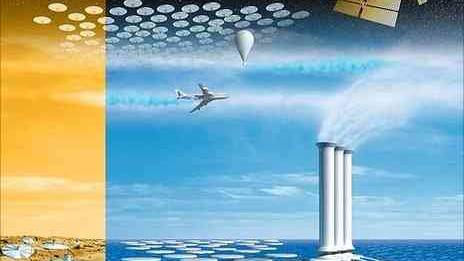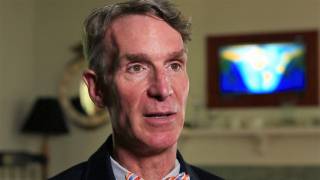The Doomsday Machine and the Race to Save the World: Geoengineering Emerges as Plan B at the 11th Hour
Source: alternet.org
How close are we to space sunshades, mountaintop painting, ’fertilizing’ the oceans with iron, and redirecting hurricanes? Closer than you might imagine.When it comes to climate change, any discussion of "cap and trade" legislation usually generates a bit of controversy, but there is another proposition for tackling our global warming woes that should be causing even more friction -- the little-known set of futurist techno-scenarios collectively known as geoengineering. At the opening plenary of the Convention on Biological Diversity last week in Nagoya, Japan, the ETC Group -- the same civil society outfit that led the charge for an international ban on Monsanto’s infamous "terminator seed" a decade ago -- called for a moratorium on geoengineering experiments. The group’s new report, Geopiracy: The Case Against Geoengineering, calls geoengineering, "a political strategy aimed at letting industrialized countries off the hook for their climate debt."
This emergent set of planetary-scale technologies is attracting millions of dollars in investment; it is high on the research agenda at the U.S. National Academy of Sciences and the UK’s Royal Society; and it is being promoted by the scientists behind it as "the only practical way to protect biodiversity." At the same time, the Washington Post has called it, "Playing God with the weather," and a leading indigenous peoples’ organization called it "an assault on the sacred."
The Intergovernmental Panel on Climate Change defines geoengineering as, "The deliberate large-scale manipulation of the planetary environment." David Keith, a leading proponent, gave the definition a touch more animus when he noted, "Climatic geoengineering aims to mitigate the effect of fossil fuel combustion on the climate without abating fossil fuel use; for example, by placing shields in space to reduce the sunlight incident on earth."
The mental image conjured by "shields in space" begins to put flesh on the bones of what geoengineering is. Keith’s declaration that a key objective of geoengineering is to maintain the status quo of fossil fuel use tells us its principle intent, and begins to hint at what its critics consider to be the grave error at the heart of the approach. Faith Gemmill, an indigenous woman from Arctic Village, Alaska and Director of REDOIL (Resisting Environmental Destruction on Indigenous Lands) says, "Geoengineering is a way for scientists to remain in denial and for governments to avoid responsibility."
The Shape of Things to Come
Geoengineering technologies fall into three categories: Weather Modification, Solar Radiation Management, and Carbon Dioxide Removal and Sequestration; each is already under intensive research, computer modeling and experimentation.
The first category, Weather Modification -- generally covering "chemical cloud seeding" and "storm modification" (the redirecting of hurricanes) -- is, conceptually, the mother of all geoengineering technologies, already practiced at significant scale in the U.S. and China. In the words of the ETC Group report, such techniques demonstrate "a classic ’end-of-pipe’ response that addresses neither the causes nor the mechanism of climate change, but seeks only to alter its outcomes."
The second set of methods is found even more literally at the end of the pipe: Carbon Dioxide Removal and Sequestration technologies attempt to remove CO2 from the atmosphere after it has been released. This is done either by mechanical means, through "carbon-sucking machines" (part of the arsenal deployed to put the "clean" in the dubious notion of "clean coal"), by modifying chemical cycles through "Ocean Fertilization" (introducing volumes of iron or nitrogen to the ocean) and "Crop Residue Ocean Permanent Sequestration" (dumping massive amounts of biomass into the sea), or by creating new carbon sinks through manipulation of species (GE algae) and ecosystems (burning biomass through pyrolysis and burying the resulting carbon, popularly promoted as "biochar").
Biochar provides an interesting perspective on both the broad range of geoengineering proposals, and the appeal. Called Terra Preta de Indio by European settlers, biochar was invented as a soil conditioner in the Amazon centuries ago; its ability to sequester carbon was recently discovered by scientists. It is perhaps the least fantastic-seeming geoengineering approach, boasting supporters such as James Lovelock and Bill McKibben’s group 350.org, with a bright green image that appeals to the same demographic that, in principal, likes compost toilets. A precipitous rise in interest in the potential world-saving properties of biochar led to the recent establishment of the International Biochar Initiative, which is lobbying the UN for carbon credits.
While elegantly simple in theory -- the direct introduction of carbon into agricultural soils -- the factor that would give biochar its world-saving quality would be deployment on a massive scale; the biochar lobby proposes planting half a billion hectares of tree plantations, then burning them and tilling the resulting charcoal into the ground.
Even setting aside thorny ethical questions of patenting traditional indigenous knowledge, the scale of application required to have a global impact could lead, immediately, to a massive disruption of populations and livelihoods, quite possibly accompanied by large-scale violations of human rights.
The third category, Solar Radiation Management, evokes classic sci-fi through techniques such as "space sunshades" (trillions of small free-flying spacecraft forming a cloud a million miles above the earth), "space mirrors" (a superfine reflective mesh between the Earth and the sun), "climate ready crops" (some engineered to have a high-gloss, reflective surface), and "mountaintop painting."
Altogether, the grandiose scope of these technologies evokes the scientific hubris of that ancient physicist Archimedes who said: "Give me a place to stand and with a lever I will move the whole world." A more recent tinkerer in biogeochemistry, John Martin, echoed that phrase in an early description of "ocean fertilization" when he said, "Give me half a tanker of iron, and I’ll give you an ice age."
While Martin’s comment, made three decades ago, was issued in apparent sarcasm, it belies an attitude, and a technological capacity, worth taking seriously. Indeed, the ETC Group took that particular technology seriously enough that it led the successful effort, beginning at a previous CBD meeting in 2008, to subject ocean fertilization to an international ban.
The Unlikely History of Climate Manipulation
In what seems like one of the little jokes of history, Bernard Vonnegut, the brother of novelist Kurt Vonnegut, was on the ground floor of geoengineering when he discovered in the 1940s that by seeding clouds with silver iodide pellets, you can -- sometimes, under very unpredictable circumstances -- stimulate rainfall. Since then, cloud seeding has enjoyed both agricultural and military uses, most notably in thousands of missions over Vietnam’s Ho Chi Minh Trail and, more recently, to ensure good weather during the Beijing Olympics and to fill hydropower reservoirs in California.
The notion of heightening the reflectivity of the earth’s surface has been around since at least 1965, when President Johnson’s Science Advisory Committee suggested addressing global warming by spreading reflective particles over the oceans.
The notion is currently embraced by counter-culture icon Stewart Brand (founder, in 1968, of Whole Earth Catalog) and his close ally, Dr. Lowell Wood. Wood, the man behind Ronald Reagan’s ill-fated Star Wars program, and a protégé of the late Doctor Edward Teller (the real-life Doctor Strangelove and inventor of the hydrogen bomb) initiated another strain of the geoengineering lineage when he gave a provocative talk in 1998 called "Geoengineering and Nuclear Fission as Responses to Global Warming."
Wood’s presentation captured the imagination of fellow researcher Ken Caldeira, who, as a 25-year-old activist in 1982 had helped organize one of the largest anti-nuke demonstrations in U.S. history; Caldeira initially tried to disprove Wood’s hypothesis, but ended up convinced of its potential for cooling the earth.
Wood and Caldeira are currently conducting joint experiments to mimic the action of a volcanic eruption by releasing sulfate particles into the stratosphere.
"The idea that you can tinker with natural systems to delay climate change seems entirely ludicrous," said Pat Mooney, the Director of ETC Group, last week at the U.N. Convention on Biological Diversity. "We began to look at this issue in 2007, and the only reason, frankly, that we took it seriously at all was because there had already been experiments by governments related to ocean fertilization. And what we noticed was that it didn’t work, and every time it didn’t work there were more experiments saying, let’s just make it bigger next time to see if we can make it work then. At the same time, we saw the private sector getting involved with an interest in generating carbon credits. So we took the matter to the U.N."
Plan B from Outer Space?
Like an example of existential satire from the mordant pulp science fiction of a Kurt Vonnegut novel, geoengineering might appear to those outside the scientific community like a strange, disquieting fantasy -- technologies bearing the dimensions of a classic sci-fi doomsday machine, with the key difference that their prime directive is not to destroy the world, but to save it.
Climate science leaves no doubt that a dramatic urgency to "save the world" is fully merited. The UNFCCC negotiations have thus far resulted only in strengthening foundations for market-based climate policies that promise to balloon corporate profits while sinking small island states and coastal territories; there are no binding targets for reducing emissions; the National Oceanic and Atmospheric Administration predicts that the Arctic may be free of summer ice within 30 years; and major ecosystems are teetering at the edge of tipping points from which there will be no return.
It is of course the very urgency of the crisis that forms the geoengineers’ bedrock justification for planetary-scale climate interventions. Last year the Royal Society, Britain’s equivalent to the U.S. National Academy of Sciences, published a report called Geoengineering the Climate: Science, Governance and Uncertainty, which concluded that geoengineering "does not present an alternative to reducing greenhouse gas emissions, which should still be the focus of efforts to avoid dangerous climate change." However," says John Shepherd, chair of the group responsible for the report, "this is proving to be difficult."
Read the full article at: AlterNet.org
Top Story Image Credit: AlterNet.org
Quote:
"It is possible to be both knowledgeable and suspicious.
After all, these are the same governments, industries and scientists responsible for climate change, who have spent trillions of dollars to protect their industries while allowing a billion people to go hungry."
~Sylvia Ribeiro, ETC Group
Also tune into:
Michael Murphy - What in the World are They Spraying?
Scott Stevens - Weather Wars, Chemtrails, Gulf Oil Spill & Environmental Destruction
Jeffrey Smith - Seeds of Deception & The Danger of Genetically Engineered Foods
Jerry E. Smith - Weather Warfare
Jerry E. Smith - Global Warming
Andrew Johnson - Chemtrails, Weather Modification & Climate Change
Sofia Smallstorm - Chemtrails, Nanotechnology & The Artificial Environment
Ian Crane - Codex Alimentarius, GMO and Artificial Food Scarcity
Freeman - Space War, the Norway Spiral, CARE, CERN, HAARP & EISCAT























